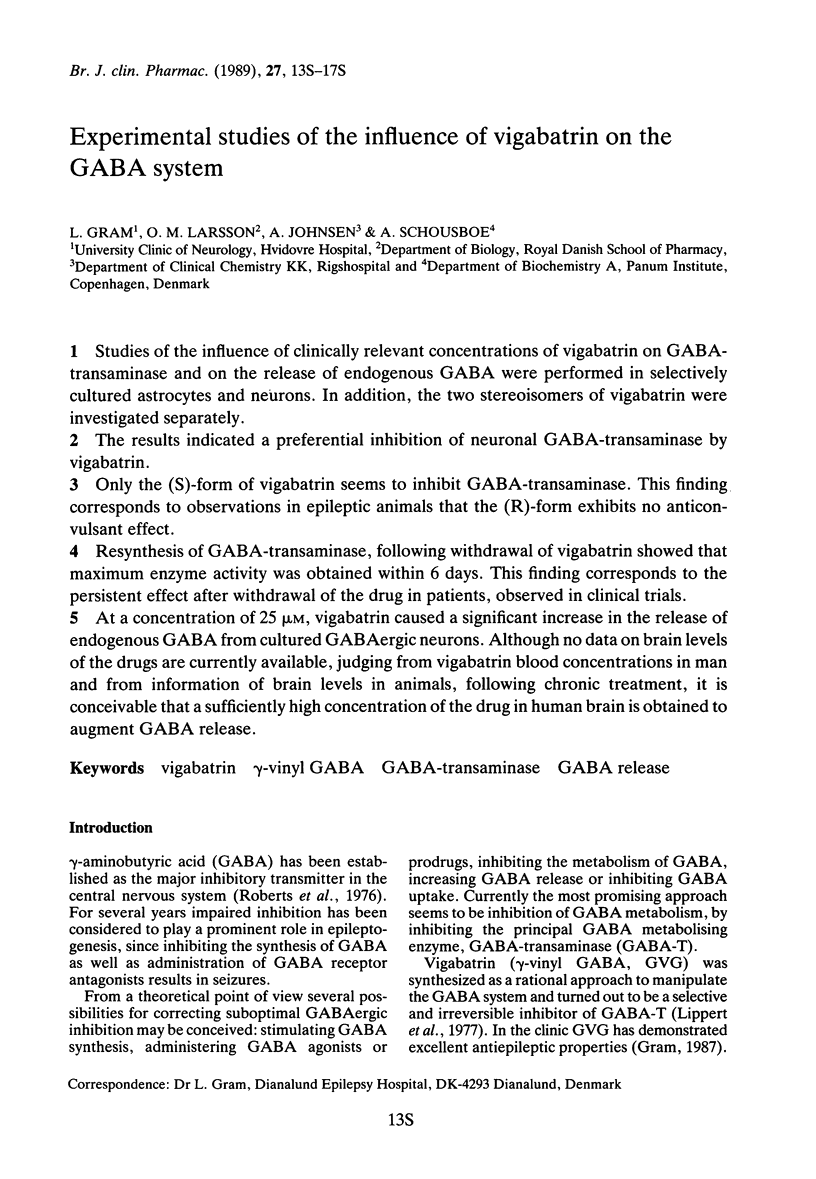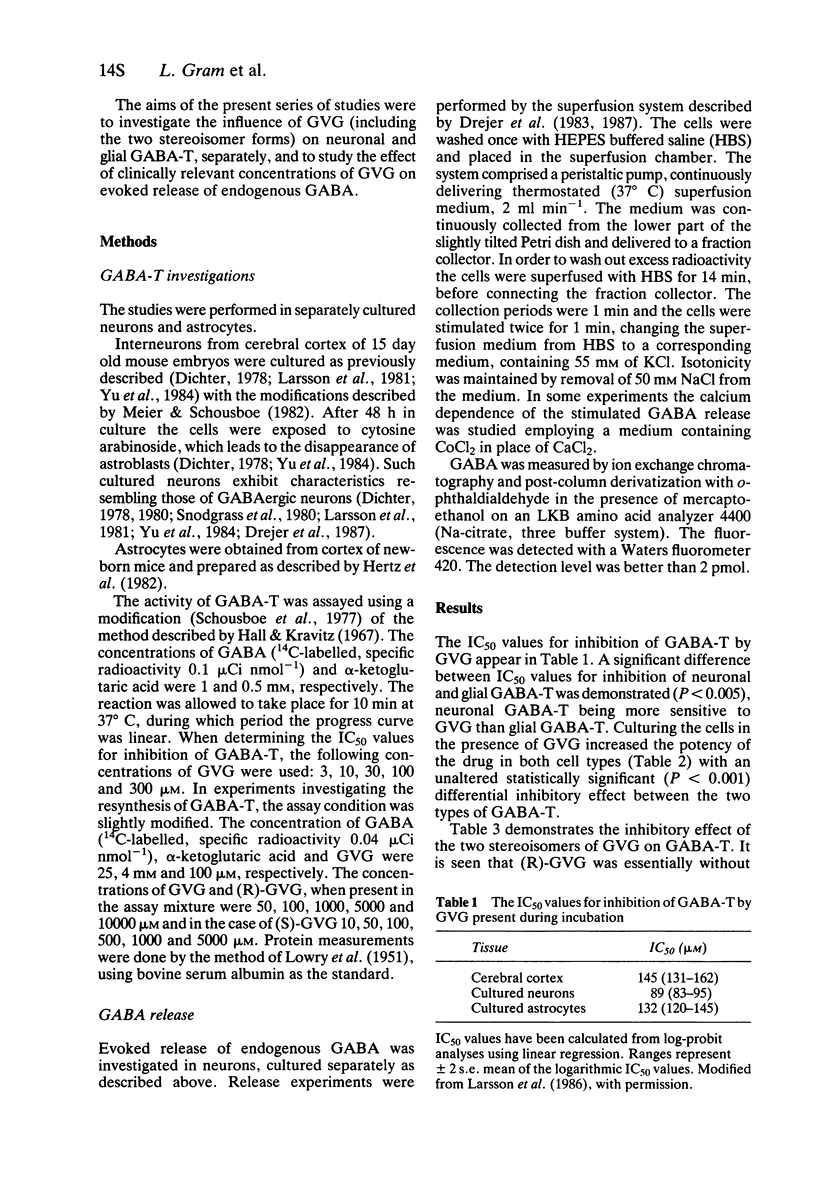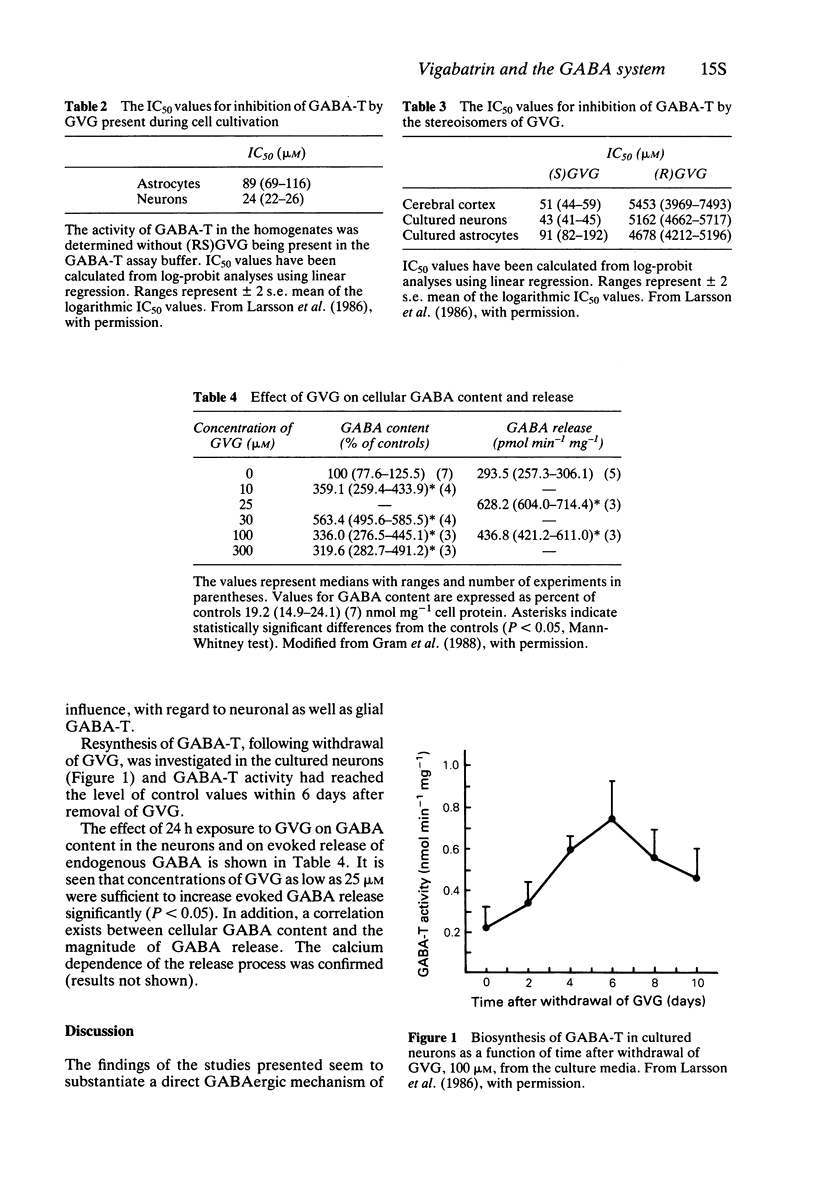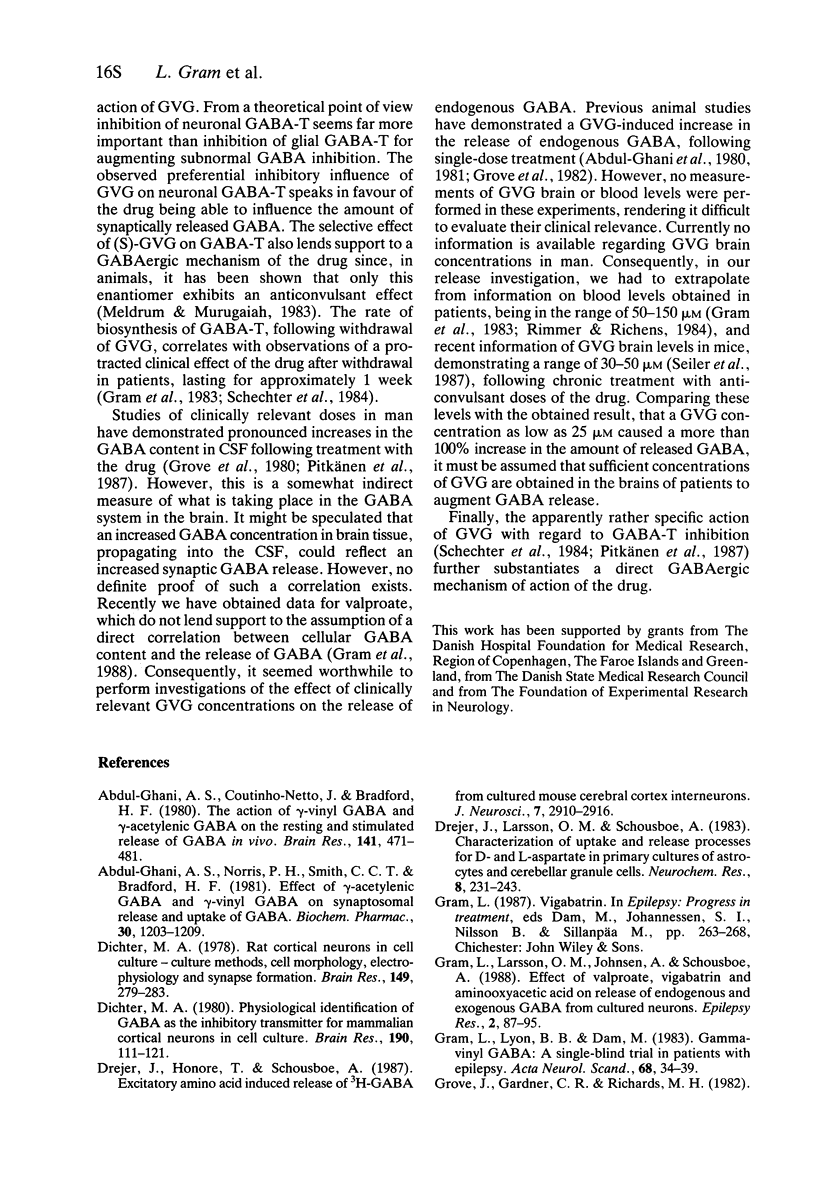Abstract
1 Studies of the influence of clinically relevant concentrations of vigabatrin on GABA-transaminase and on the release of endogenous GABA were performed in selectively cultured astrocytes and neurons. In addition, the two stereoisomers of vigabatrin were investigated separately.
2 The results indicated a preferential inhibition of neuronal GABA-transaminase by vigabatrin.
3 Only the (S)-form of vigabatrin seems to inhibit GABA-transaminase. This finding corresponds to observations in epileptic animals that the (R)-form exhibits no anticonvulsant effect.
4 Resynthesis of GABA-transaminase, following withdrawal of vigabatrin showed that maximum enzyme activity was obtained within 6 days. This finding corresponds to the persistent effect after withdrawal of the drug in patients, observed in clinical trials.
5 At a concentration of 25 μM, vigabatrin caused a significant increase in the release of endogenous GABA from cultured GABAergic neurons. Although no data on brain levels of the drugs are currently available, judging from vigabatrin blood concentrations in man and from information of brain levels in animals, following chronic treatment, it is conceivable that a sufficiently high concentration of the drug in human brain is obtained to augment GABA release.
Keywords: vigabatrin, γ-vinyl GABA, GABA-transaminase, GABA release
Full text
PDF




Selected References
These references are in PubMed. This may not be the complete list of references from this article.
- Abdul-Ghani A. S., Coutinho-Netto J., Bradford H. F. The action of gamma-vinyl-GABA and gamma-acetylenic-GABA on the resting and stimulated release of GABA in vivo. Brain Res. 1980 Jun 9;191(2):471–481. doi: 10.1016/0006-8993(80)91295-0. [DOI] [PubMed] [Google Scholar]
- Abdul-Ghani A. S., Norris P. J., Smith C. C., Bradford H. F. Effects of gamma-acetylenic GABA and gamma-vinyl GABA on synaptosomal release and uptake of GABA. Biochem Pharmacol. 1981 Jun 1;30(11):1203–1209. doi: 10.1016/0006-2952(81)90298-7. [DOI] [PubMed] [Google Scholar]
- Dichter M. A. Physiological identification of GABA as the inhibitory transmitter for mammalian cortical neurons in cell culture. Brain Res. 1980 May 19;190(1):111–121. doi: 10.1016/0006-8993(80)91163-4. [DOI] [PubMed] [Google Scholar]
- Dichter M. A. Rat cortical neurons in cell culture: culture methods, cell morphology, electrophysiology, and synapse formation. Brain Res. 1978 Jun 30;149(2):279–293. doi: 10.1016/0006-8993(78)90476-6. [DOI] [PubMed] [Google Scholar]
- Drejer J., Honoré T., Schousboe A. Excitatory amino acid-induced release of 3H-GABA from cultured mouse cerebral cortex interneurons. J Neurosci. 1987 Sep;7(9):2910–2916. doi: 10.1523/JNEUROSCI.07-09-02910.1987. [DOI] [PMC free article] [PubMed] [Google Scholar]
- Drejer J., Larsson O. M., Schousboe A. Characterization of uptake and release processes for D- and L-aspartate in primary cultures of astrocytes and cerebellar granule cells. Neurochem Res. 1983 Feb;8(2):231–243. doi: 10.1007/BF00963923. [DOI] [PubMed] [Google Scholar]
- Gram L., Larsson O. M., Johnsen A. H., Schousboe A. Effects of valproate, vigabatrin and aminooxyacetic acid on release of endogenous and exogenous GABA from cultured neurons. Epilepsy Res. 1988 Mar-Apr;2(2):87–95. doi: 10.1016/0920-1211(88)90024-1. [DOI] [PubMed] [Google Scholar]
- Gram L., Lyon B. B., Dam M. Gamma-vinyl-GABA: a single-blind trial in patients with epilepsy. Acta Neurol Scand. 1983 Jul;68(1):34–39. doi: 10.1111/j.1600-0404.1983.tb04812.x. [DOI] [PubMed] [Google Scholar]
- Grove J., Gardner C. R., Richards M. H. Measurement of release of endogenous GABA and catabolites of [3H]GABA from synaptosomal preparations using ion-exchange chromatography. Neurochem Res. 1982 May;7(5):589–599. doi: 10.1007/BF00965125. [DOI] [PubMed] [Google Scholar]
- Grove J., Tell G., Schechter P. J., Koch-Weser J., Warter J. M., Marescaux C., Rumbach L. Increased CSF gamma-aminobutyric acid after treatment with gamma-vinyl GABA. Lancet. 1980 Sep 20;2(8195 Pt 1):647–647. doi: 10.1016/s0140-6736(80)90318-9. [DOI] [PubMed] [Google Scholar]
- Hall Z. W., Kravitz E. A. The metabolism of gamma-aminobutyric acid (GABA) in the lobster nervous system. I. GABA-glutamate transaminase. J Neurochem. 1967 Jan;14(1):45–54. doi: 10.1111/j.1471-4159.1967.tb09492.x. [DOI] [PubMed] [Google Scholar]
- LOWRY O. H., ROSEBROUGH N. J., FARR A. L., RANDALL R. J. Protein measurement with the Folin phenol reagent. J Biol Chem. 1951 Nov;193(1):265–275. [PubMed] [Google Scholar]
- Larsson O. M., Gram L., Schousboe I., Schousboe A. Differential effect of gamma-vinyl GABA and valproate on GABA-transaminase from cultured neurones and astrocytes. Neuropharmacology. 1986 Jun;25(6):617–625. doi: 10.1016/0028-3908(86)90214-5. [DOI] [PubMed] [Google Scholar]
- Larsson O. M., Thorbek P., Krogsgaard-Larsen P., Schousboe A. Effect of homo-beta-proline and other heterocyclic GABA analogues on GABA uptake in neurons and astroglial cells and on GABA receptor binding. J Neurochem. 1981 Dec;37(6):1509–1516. doi: 10.1111/j.1471-4159.1981.tb06320.x. [DOI] [PubMed] [Google Scholar]
- Lippert B., Metcalf B. W., Jung M. J., Casara P. 4-amino-hex-5-enoic acid, a selective catalytic inhibitor of 4-aminobutyric-acid aminotransferase in mammalian brain. Eur J Biochem. 1977 Apr 15;74(3):441–445. doi: 10.1111/j.1432-1033.1977.tb11410.x. [DOI] [PubMed] [Google Scholar]
- Meier E., Schousboe A. Differences between GABA receptor binding to membranes from cerebellum during postnatal development and from cultured cerebellar granule cells. Dev Neurosci. 1982;5(5-6):546–553. doi: 10.1159/000112716. [DOI] [PubMed] [Google Scholar]
- Meldrum B. S., Murugaiah K. Anticonvulsant action in mice with sound-induced seizures of the optical isomers of gamma-vinyl GABA. Eur J Pharmacol. 1983 Apr 22;89(1-2):149–152. doi: 10.1016/0014-2999(83)90620-9. [DOI] [PubMed] [Google Scholar]
- Pitkänen A., Halonen T., Ylinen A., Riekkinen P. Somatostatin, beta-endorphin, and prolactin levels in human cerebrospinal fluid during the gamma-vinyl-GABA treatment of patients with complex partial epilepsy. Neuropeptides. 1987 Apr;9(3):185–195. doi: 10.1016/0143-4179(87)90038-2. [DOI] [PubMed] [Google Scholar]
- Rimmer E. M., Richens A. Double-blind study of gamma-vinyl GABA in patients with refractory epilepsy. Lancet. 1984 Jan 28;1(8370):189–190. doi: 10.1016/s0140-6736(84)92112-3. [DOI] [PubMed] [Google Scholar]
- Schechter P. J., Hanke N. F., Grove J., Huebert N., Sjoerdsma A. Biochemical and clinical effects of gamma-vinyl GABA in patients with epilepsy. Neurology. 1984 Feb;34(2):182–186. doi: 10.1212/wnl.34.2.182. [DOI] [PubMed] [Google Scholar]
- Snodgrass S. R., White W. F., Biales B., Dichter M. Biochemical correlates of GABA function in rat cortical neurons in culture. Brain Res. 1980 May 19;190(1):123–138. doi: 10.1016/0006-8993(80)91164-6. [DOI] [PubMed] [Google Scholar]
- Yu A. C., Hertz E., Hertz L. Alterations in uptake and release rates for GABA, glutamate, and glutamine during biochemical maturation of highly purified cultures of cerebral cortical neurons, a GABAergic preparation. J Neurochem. 1984 Apr;42(4):951–960. doi: 10.1111/j.1471-4159.1984.tb12696.x. [DOI] [PubMed] [Google Scholar]


